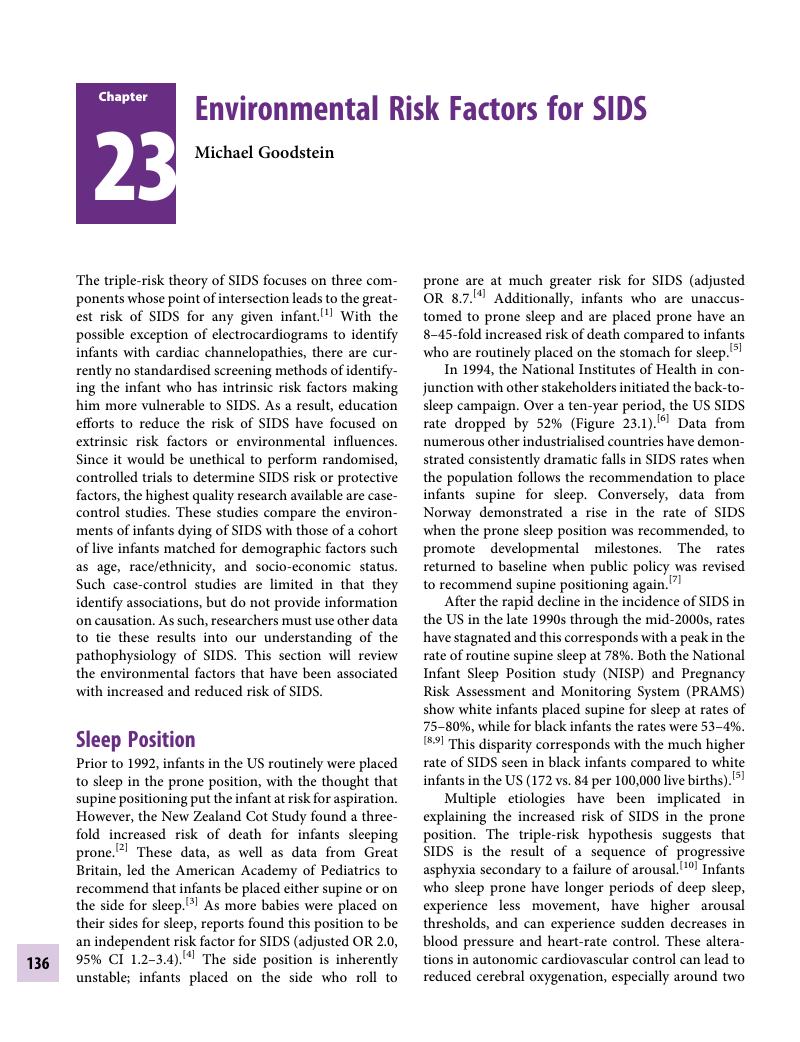Book contents
- Investigation of Sudden Infant Death Syndrome
- Diagnostic Pediatric Pathology
- Investigation of Sudden Infant Death Syndrome
- Copyright page
- Contents
- Contributors
- Foreword
- Preface
- Section 1 The History of SIDS
- Section 2 The Parents
- Section 3 Legal Framework
- Section 4 Best Practices Protocols of Investigation of Sudden Unexpected Death in Infancy and Childhood
- Section 5 Autopsy Findings
- Section 6 Epidemiology and Risk Factors
- Chapter 19 Biological Factors
- Chapter 20 Risk of Recurrent Sudden Infant Death Syndrome in Families
- Chapter 21 Prenatal and Postpartum Nicotine Exposure
- Chapter 22 Misuse of Drugs in Pregnancy
- Chapter 23 Environmental Risk Factors for SIDS
- Chapter 24 The Relationship Between Breastfeeding and SIDS
- Chapter 25 Pacifier Use and SIDS
- Chapter 26 Bed-sharing: What is the Evidence?
- Chapter 27 Child-care Environment
- Section 7 Pathophysiology
- Section 8 SUDI/SUID Which is Not SIDS
- Index
- References
Chapter 23 - Environmental Risk Factors for SIDS
from Section 6 - Epidemiology and Risk Factors
Published online by Cambridge University Press: 04 June 2019
- Investigation of Sudden Infant Death Syndrome
- Diagnostic Pediatric Pathology
- Investigation of Sudden Infant Death Syndrome
- Copyright page
- Contents
- Contributors
- Foreword
- Preface
- Section 1 The History of SIDS
- Section 2 The Parents
- Section 3 Legal Framework
- Section 4 Best Practices Protocols of Investigation of Sudden Unexpected Death in Infancy and Childhood
- Section 5 Autopsy Findings
- Section 6 Epidemiology and Risk Factors
- Chapter 19 Biological Factors
- Chapter 20 Risk of Recurrent Sudden Infant Death Syndrome in Families
- Chapter 21 Prenatal and Postpartum Nicotine Exposure
- Chapter 22 Misuse of Drugs in Pregnancy
- Chapter 23 Environmental Risk Factors for SIDS
- Chapter 24 The Relationship Between Breastfeeding and SIDS
- Chapter 25 Pacifier Use and SIDS
- Chapter 26 Bed-sharing: What is the Evidence?
- Chapter 27 Child-care Environment
- Section 7 Pathophysiology
- Section 8 SUDI/SUID Which is Not SIDS
- Index
- References
Summary

- Type
- Chapter
- Information
- Investigation of Sudden Infant Death Syndrome , pp. 136 - 141Publisher: Cambridge University PressPrint publication year: 2019

